Food Service Management, Supply Chain & Ethics - Gordon Ramsay
VerifiedAdded on 2023/06/12
|11
|3304
|426
Report
AI Summary
This report provides an overview of strategic food service management practices within the context of Gordon Ramsay Restaurant, focusing on its operations in Chelsea, London, UK. It examines various food service contexts, including fine dining, casual dining, and fast food, highlighting the restaurant's position as a Michelin-starred establishment with a global presence. The report details the key stakeholders in Gordon Ramsay's food supply chain, from farmers and processors to distributors, retailers, and consumers, and differentiates between longer and shorter supply chain approaches. It further elaborates on the principles of effective procurement and sourcing processes, emphasizing the importance of supplier selection, purchase requisition, and invoice management. Analytical tools such as SWOT and PESTEL analyses are applied to evaluate the restaurant's strengths, weaknesses, opportunities, threats, and the impact of external environmental factors. The report concludes by discussing the ethical practices adopted by Gordon Ramsay Restaurant and their influence on its overall business success.

25 Food Service
Management
Management
Paraphrase This Document
Need a fresh take? Get an instant paraphrase of this document with our AI Paraphraser
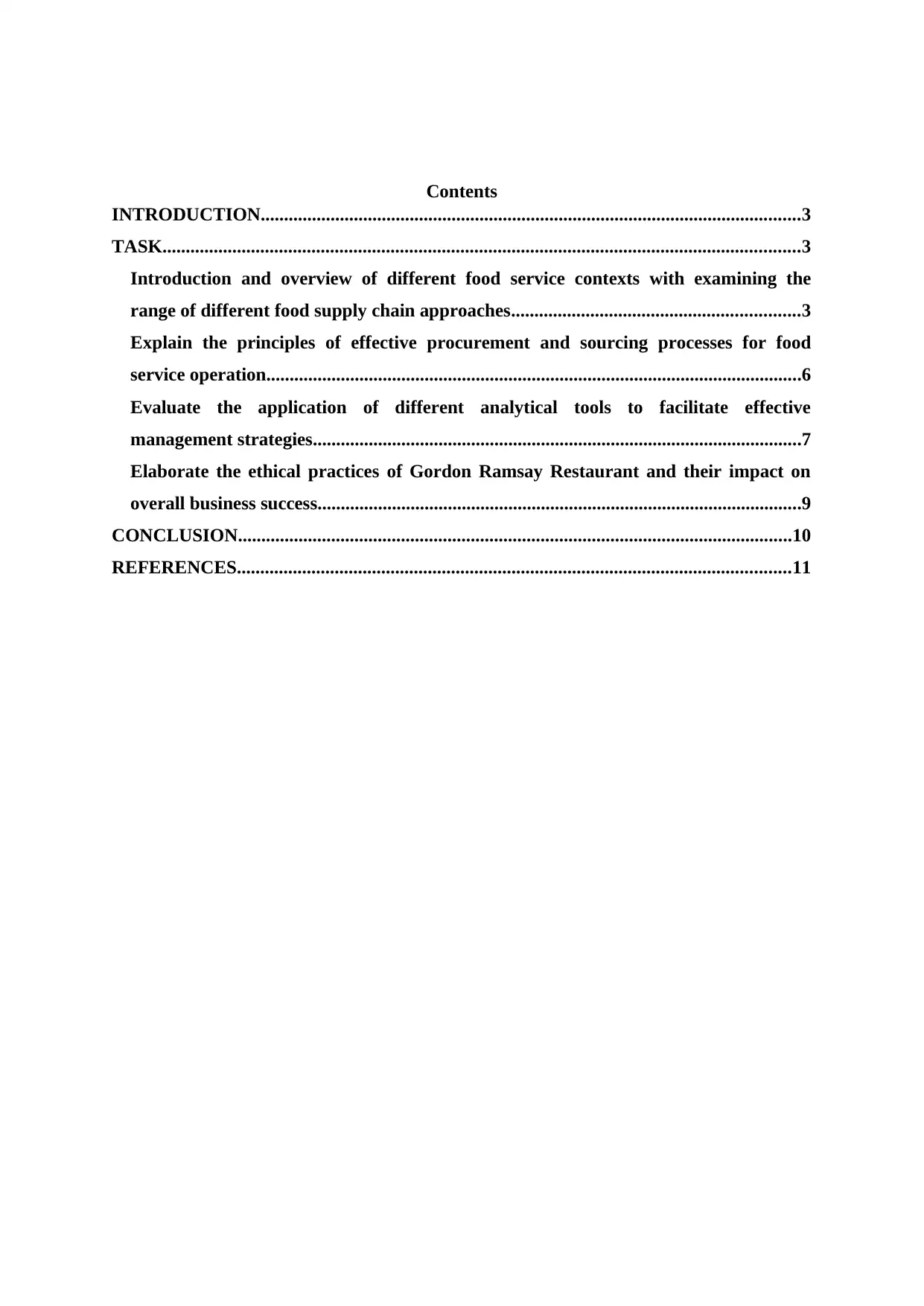
Contents
INTRODUCTION....................................................................................................................3
TASK.........................................................................................................................................3
Introduction and overview of different food service contexts with examining the
range of different food supply chain approaches..............................................................3
Explain the principles of effective procurement and sourcing processes for food
service operation...................................................................................................................6
Evaluate the application of different analytical tools to facilitate effective
management strategies.........................................................................................................7
Elaborate the ethical practices of Gordon Ramsay Restaurant and their impact on
overall business success........................................................................................................9
CONCLUSION.......................................................................................................................10
REFERENCES.......................................................................................................................11
INTRODUCTION....................................................................................................................3
TASK.........................................................................................................................................3
Introduction and overview of different food service contexts with examining the
range of different food supply chain approaches..............................................................3
Explain the principles of effective procurement and sourcing processes for food
service operation...................................................................................................................6
Evaluate the application of different analytical tools to facilitate effective
management strategies.........................................................................................................7
Elaborate the ethical practices of Gordon Ramsay Restaurant and their impact on
overall business success........................................................................................................9
CONCLUSION.......................................................................................................................10
REFERENCES.......................................................................................................................11
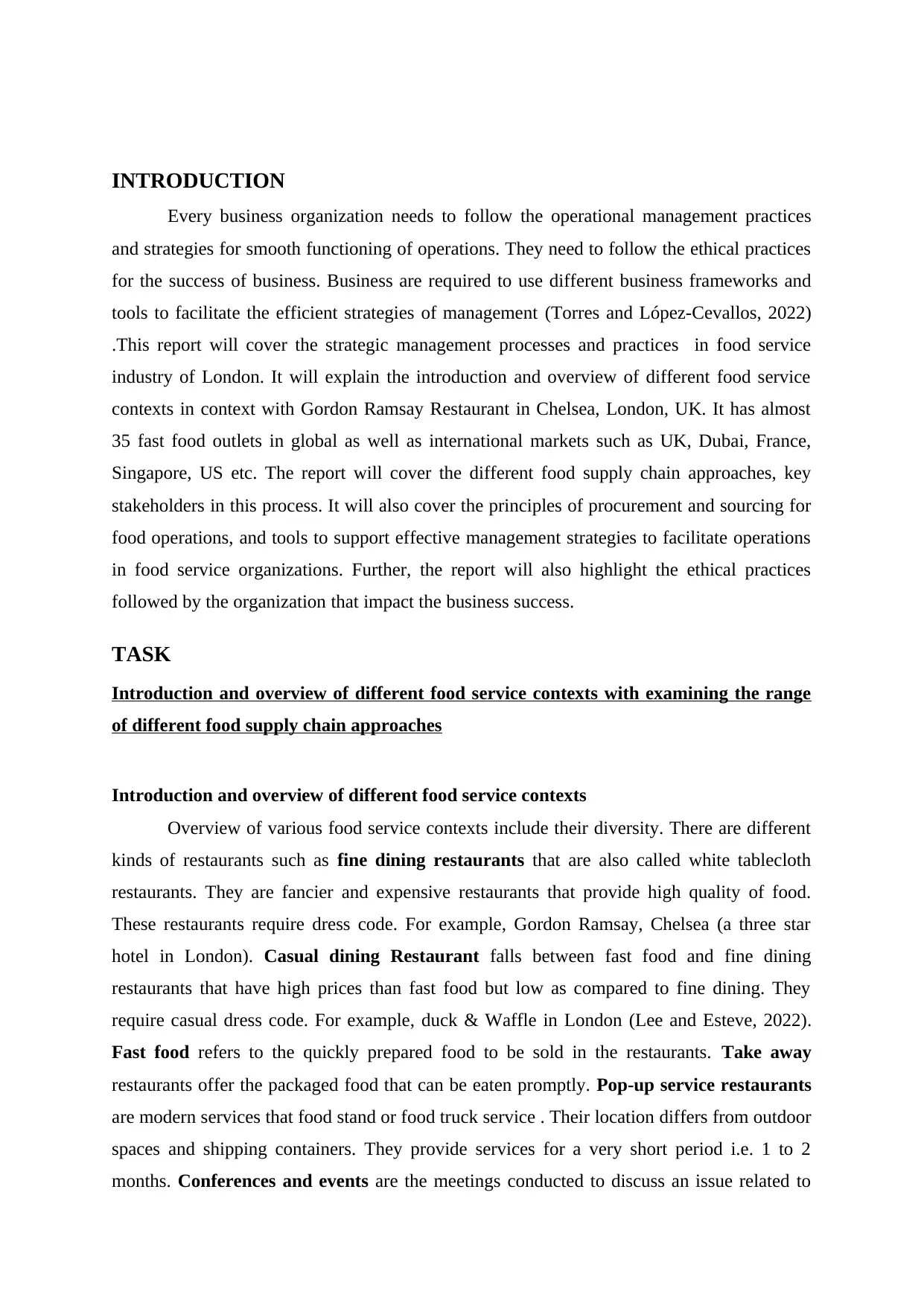
INTRODUCTION
Every business organization needs to follow the operational management practices
and strategies for smooth functioning of operations. They need to follow the ethical practices
for the success of business. Business are required to use different business frameworks and
tools to facilitate the efficient strategies of management (Torres and López-Cevallos, 2022)
.This report will cover the strategic management processes and practices in food service
industry of London. It will explain the introduction and overview of different food service
contexts in context with Gordon Ramsay Restaurant in Chelsea, London, UK. It has almost
35 fast food outlets in global as well as international markets such as UK, Dubai, France,
Singapore, US etc. The report will cover the different food supply chain approaches, key
stakeholders in this process. It will also cover the principles of procurement and sourcing for
food operations, and tools to support effective management strategies to facilitate operations
in food service organizations. Further, the report will also highlight the ethical practices
followed by the organization that impact the business success.
TASK
Introduction and overview of different food service contexts with examining the range
of different food supply chain approaches
Introduction and overview of different food service contexts
Overview of various food service contexts include their diversity. There are different
kinds of restaurants such as fine dining restaurants that are also called white tablecloth
restaurants. They are fancier and expensive restaurants that provide high quality of food.
These restaurants require dress code. For example, Gordon Ramsay, Chelsea (a three star
hotel in London). Casual dining Restaurant falls between fast food and fine dining
restaurants that have high prices than fast food but low as compared to fine dining. They
require casual dress code. For example, duck & Waffle in London (Lee and Esteve, 2022).
Fast food refers to the quickly prepared food to be sold in the restaurants. Take away
restaurants offer the packaged food that can be eaten promptly. Pop-up service restaurants
are modern services that food stand or food truck service . Their location differs from outdoor
spaces and shipping containers. They provide services for a very short period i.e. 1 to 2
months. Conferences and events are the meetings conducted to discuss an issue related to
Every business organization needs to follow the operational management practices
and strategies for smooth functioning of operations. They need to follow the ethical practices
for the success of business. Business are required to use different business frameworks and
tools to facilitate the efficient strategies of management (Torres and López-Cevallos, 2022)
.This report will cover the strategic management processes and practices in food service
industry of London. It will explain the introduction and overview of different food service
contexts in context with Gordon Ramsay Restaurant in Chelsea, London, UK. It has almost
35 fast food outlets in global as well as international markets such as UK, Dubai, France,
Singapore, US etc. The report will cover the different food supply chain approaches, key
stakeholders in this process. It will also cover the principles of procurement and sourcing for
food operations, and tools to support effective management strategies to facilitate operations
in food service organizations. Further, the report will also highlight the ethical practices
followed by the organization that impact the business success.
TASK
Introduction and overview of different food service contexts with examining the range
of different food supply chain approaches
Introduction and overview of different food service contexts
Overview of various food service contexts include their diversity. There are different
kinds of restaurants such as fine dining restaurants that are also called white tablecloth
restaurants. They are fancier and expensive restaurants that provide high quality of food.
These restaurants require dress code. For example, Gordon Ramsay, Chelsea (a three star
hotel in London). Casual dining Restaurant falls between fast food and fine dining
restaurants that have high prices than fast food but low as compared to fine dining. They
require casual dress code. For example, duck & Waffle in London (Lee and Esteve, 2022).
Fast food refers to the quickly prepared food to be sold in the restaurants. Take away
restaurants offer the packaged food that can be eaten promptly. Pop-up service restaurants
are modern services that food stand or food truck service . Their location differs from outdoor
spaces and shipping containers. They provide services for a very short period i.e. 1 to 2
months. Conferences and events are the meetings conducted to discuss an issue related to
⊘ This is a preview!⊘
Do you want full access?
Subscribe today to unlock all pages.

Trusted by 1+ million students worldwide
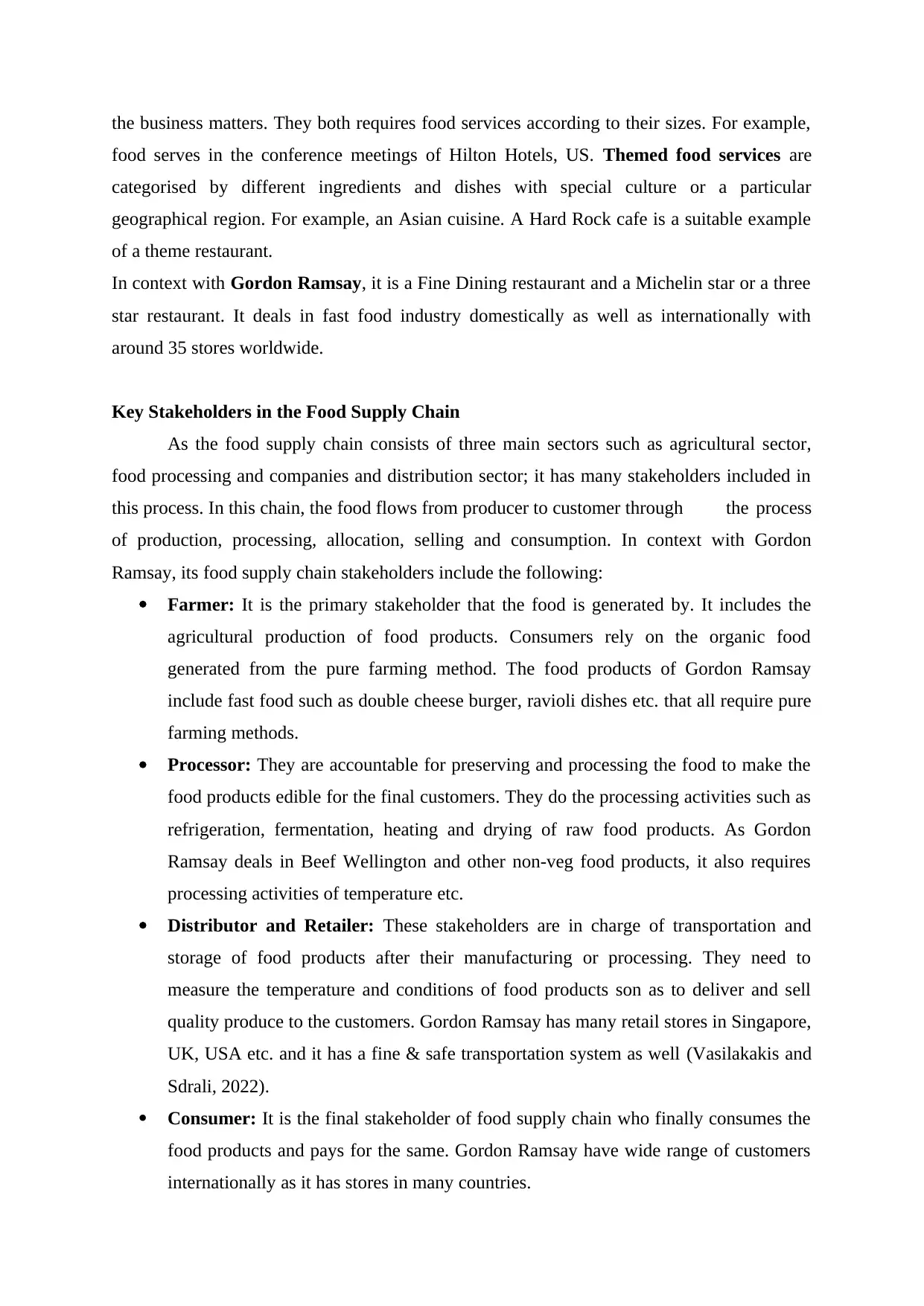
the business matters. They both requires food services according to their sizes. For example,
food serves in the conference meetings of Hilton Hotels, US. Themed food services are
categorised by different ingredients and dishes with special culture or a particular
geographical region. For example, an Asian cuisine. A Hard Rock cafe is a suitable example
of a theme restaurant.
In context with Gordon Ramsay, it is a Fine Dining restaurant and a Michelin star or a three
star restaurant. It deals in fast food industry domestically as well as internationally with
around 35 stores worldwide.
Key Stakeholders in the Food Supply Chain
As the food supply chain consists of three main sectors such as agricultural sector,
food processing and companies and distribution sector; it has many stakeholders included in
this process. In this chain, the food flows from producer to customer through the process
of production, processing, allocation, selling and consumption. In context with Gordon
Ramsay, its food supply chain stakeholders include the following:
Farmer: It is the primary stakeholder that the food is generated by. It includes the
agricultural production of food products. Consumers rely on the organic food
generated from the pure farming method. The food products of Gordon Ramsay
include fast food such as double cheese burger, ravioli dishes etc. that all require pure
farming methods.
Processor: They are accountable for preserving and processing the food to make the
food products edible for the final customers. They do the processing activities such as
refrigeration, fermentation, heating and drying of raw food products. As Gordon
Ramsay deals in Beef Wellington and other non-veg food products, it also requires
processing activities of temperature etc.
Distributor and Retailer: These stakeholders are in charge of transportation and
storage of food products after their manufacturing or processing. They need to
measure the temperature and conditions of food products son as to deliver and sell
quality produce to the customers. Gordon Ramsay has many retail stores in Singapore,
UK, USA etc. and it has a fine & safe transportation system as well (Vasilakakis and
Sdrali, 2022).
Consumer: It is the final stakeholder of food supply chain who finally consumes the
food products and pays for the same. Gordon Ramsay have wide range of customers
internationally as it has stores in many countries.
food serves in the conference meetings of Hilton Hotels, US. Themed food services are
categorised by different ingredients and dishes with special culture or a particular
geographical region. For example, an Asian cuisine. A Hard Rock cafe is a suitable example
of a theme restaurant.
In context with Gordon Ramsay, it is a Fine Dining restaurant and a Michelin star or a three
star restaurant. It deals in fast food industry domestically as well as internationally with
around 35 stores worldwide.
Key Stakeholders in the Food Supply Chain
As the food supply chain consists of three main sectors such as agricultural sector,
food processing and companies and distribution sector; it has many stakeholders included in
this process. In this chain, the food flows from producer to customer through the process
of production, processing, allocation, selling and consumption. In context with Gordon
Ramsay, its food supply chain stakeholders include the following:
Farmer: It is the primary stakeholder that the food is generated by. It includes the
agricultural production of food products. Consumers rely on the organic food
generated from the pure farming method. The food products of Gordon Ramsay
include fast food such as double cheese burger, ravioli dishes etc. that all require pure
farming methods.
Processor: They are accountable for preserving and processing the food to make the
food products edible for the final customers. They do the processing activities such as
refrigeration, fermentation, heating and drying of raw food products. As Gordon
Ramsay deals in Beef Wellington and other non-veg food products, it also requires
processing activities of temperature etc.
Distributor and Retailer: These stakeholders are in charge of transportation and
storage of food products after their manufacturing or processing. They need to
measure the temperature and conditions of food products son as to deliver and sell
quality produce to the customers. Gordon Ramsay has many retail stores in Singapore,
UK, USA etc. and it has a fine & safe transportation system as well (Vasilakakis and
Sdrali, 2022).
Consumer: It is the final stakeholder of food supply chain who finally consumes the
food products and pays for the same. Gordon Ramsay have wide range of customers
internationally as it has stores in many countries.
Paraphrase This Document
Need a fresh take? Get an instant paraphrase of this document with our AI Paraphraser
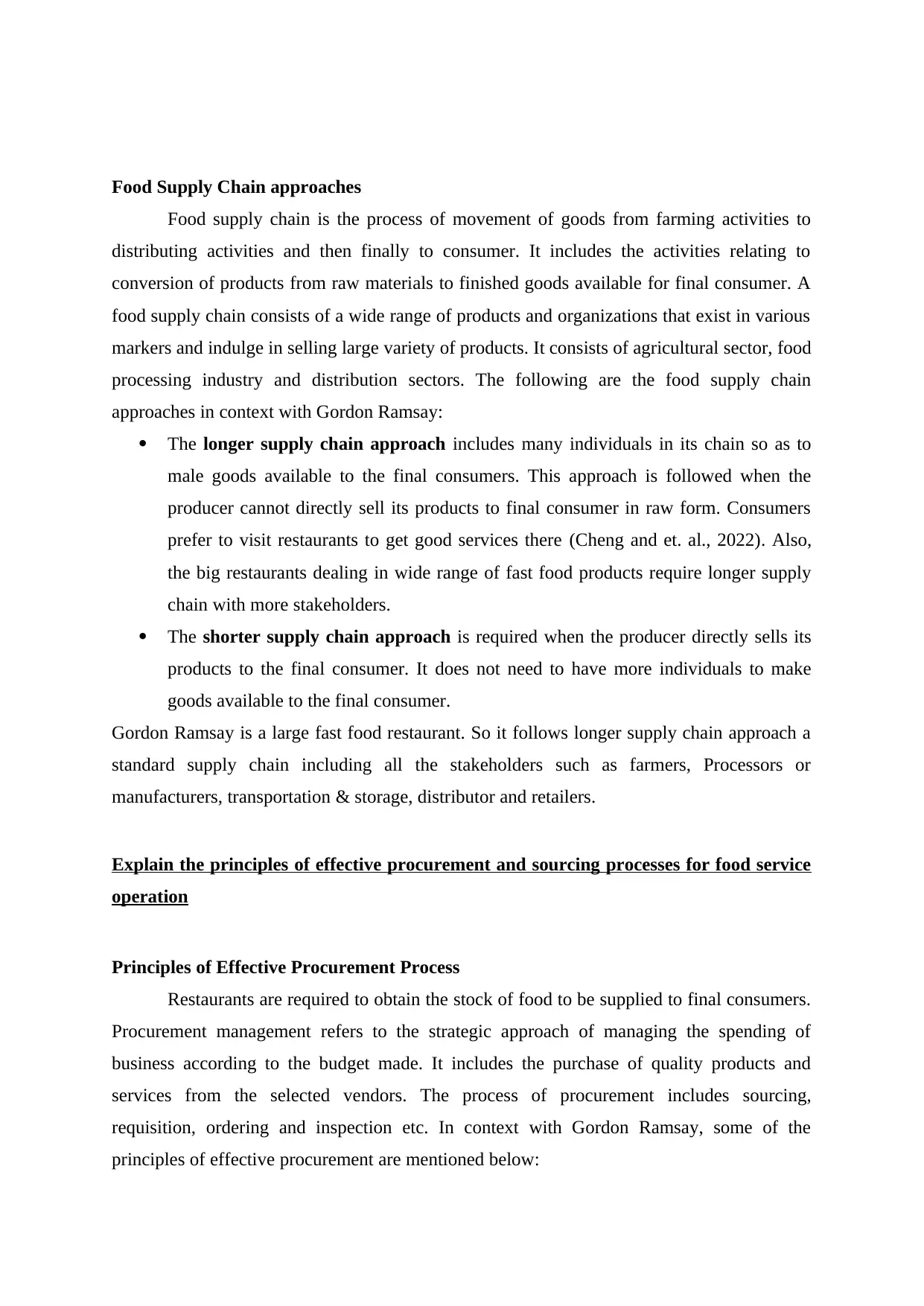
Food Supply Chain approaches
Food supply chain is the process of movement of goods from farming activities to
distributing activities and then finally to consumer. It includes the activities relating to
conversion of products from raw materials to finished goods available for final consumer. A
food supply chain consists of a wide range of products and organizations that exist in various
markers and indulge in selling large variety of products. It consists of agricultural sector, food
processing industry and distribution sectors. The following are the food supply chain
approaches in context with Gordon Ramsay:
The longer supply chain approach includes many individuals in its chain so as to
male goods available to the final consumers. This approach is followed when the
producer cannot directly sell its products to final consumer in raw form. Consumers
prefer to visit restaurants to get good services there (Cheng and et. al., 2022). Also,
the big restaurants dealing in wide range of fast food products require longer supply
chain with more stakeholders.
The shorter supply chain approach is required when the producer directly sells its
products to the final consumer. It does not need to have more individuals to make
goods available to the final consumer.
Gordon Ramsay is a large fast food restaurant. So it follows longer supply chain approach a
standard supply chain including all the stakeholders such as farmers, Processors or
manufacturers, transportation & storage, distributor and retailers.
Explain the principles of effective procurement and sourcing processes for food service
operation
Principles of Effective Procurement Process
Restaurants are required to obtain the stock of food to be supplied to final consumers.
Procurement management refers to the strategic approach of managing the spending of
business according to the budget made. It includes the purchase of quality products and
services from the selected vendors. The process of procurement includes sourcing,
requisition, ordering and inspection etc. In context with Gordon Ramsay, some of the
principles of effective procurement are mentioned below:
Food supply chain is the process of movement of goods from farming activities to
distributing activities and then finally to consumer. It includes the activities relating to
conversion of products from raw materials to finished goods available for final consumer. A
food supply chain consists of a wide range of products and organizations that exist in various
markers and indulge in selling large variety of products. It consists of agricultural sector, food
processing industry and distribution sectors. The following are the food supply chain
approaches in context with Gordon Ramsay:
The longer supply chain approach includes many individuals in its chain so as to
male goods available to the final consumers. This approach is followed when the
producer cannot directly sell its products to final consumer in raw form. Consumers
prefer to visit restaurants to get good services there (Cheng and et. al., 2022). Also,
the big restaurants dealing in wide range of fast food products require longer supply
chain with more stakeholders.
The shorter supply chain approach is required when the producer directly sells its
products to the final consumer. It does not need to have more individuals to make
goods available to the final consumer.
Gordon Ramsay is a large fast food restaurant. So it follows longer supply chain approach a
standard supply chain including all the stakeholders such as farmers, Processors or
manufacturers, transportation & storage, distributor and retailers.
Explain the principles of effective procurement and sourcing processes for food service
operation
Principles of Effective Procurement Process
Restaurants are required to obtain the stock of food to be supplied to final consumers.
Procurement management refers to the strategic approach of managing the spending of
business according to the budget made. It includes the purchase of quality products and
services from the selected vendors. The process of procurement includes sourcing,
requisition, ordering and inspection etc. In context with Gordon Ramsay, some of the
principles of effective procurement are mentioned below:
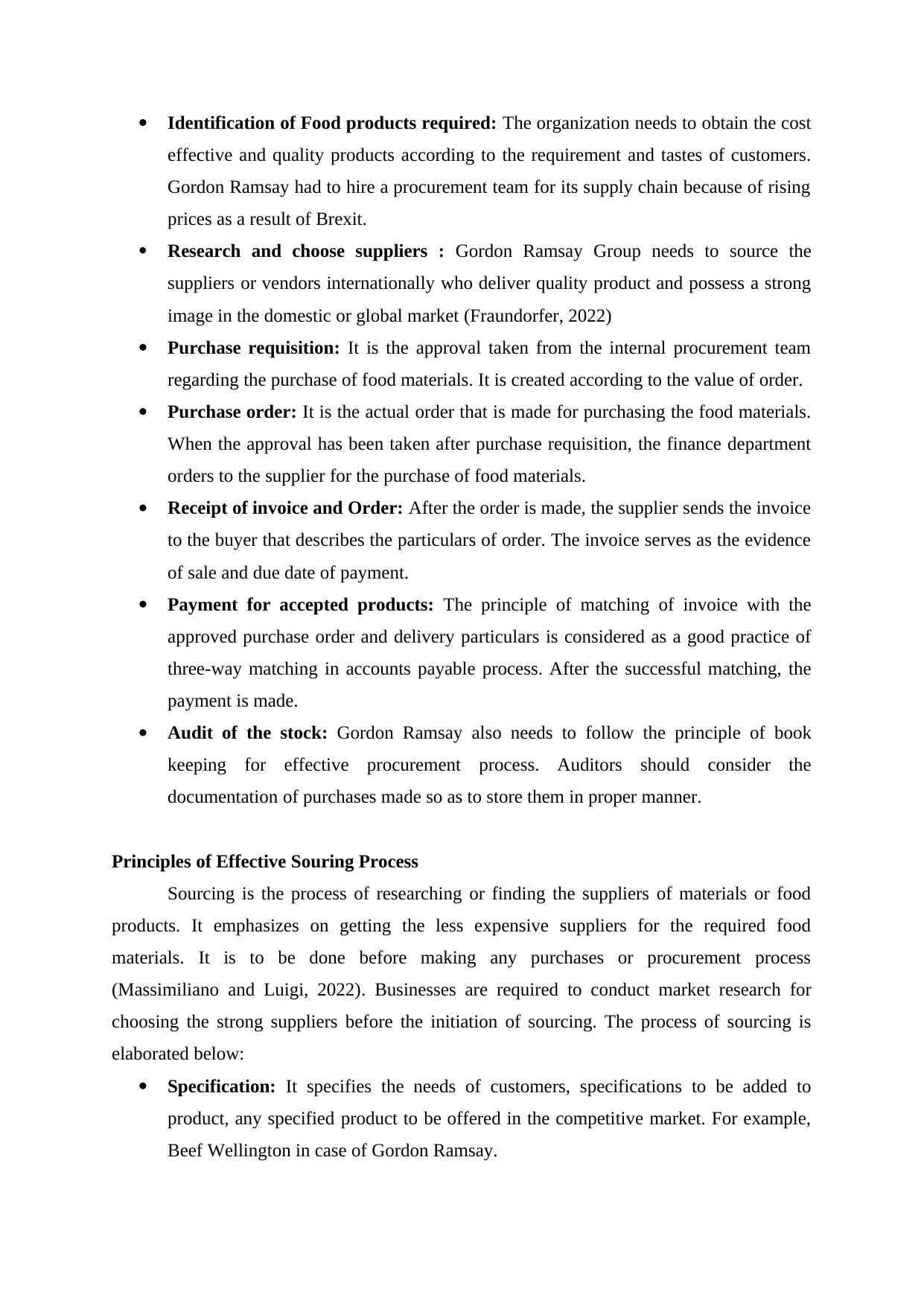
Identification of Food products required: The organization needs to obtain the cost
effective and quality products according to the requirement and tastes of customers.
Gordon Ramsay had to hire a procurement team for its supply chain because of rising
prices as a result of Brexit.
Research and choose suppliers : Gordon Ramsay Group needs to source the
suppliers or vendors internationally who deliver quality product and possess a strong
image in the domestic or global market (Fraundorfer, 2022)
Purchase requisition: It is the approval taken from the internal procurement team
regarding the purchase of food materials. It is created according to the value of order.
Purchase order: It is the actual order that is made for purchasing the food materials.
When the approval has been taken after purchase requisition, the finance department
orders to the supplier for the purchase of food materials.
Receipt of invoice and Order: After the order is made, the supplier sends the invoice
to the buyer that describes the particulars of order. The invoice serves as the evidence
of sale and due date of payment.
Payment for accepted products: The principle of matching of invoice with the
approved purchase order and delivery particulars is considered as a good practice of
three-way matching in accounts payable process. After the successful matching, the
payment is made.
Audit of the stock: Gordon Ramsay also needs to follow the principle of book
keeping for effective procurement process. Auditors should consider the
documentation of purchases made so as to store them in proper manner.
Principles of Effective Souring Process
Sourcing is the process of researching or finding the suppliers of materials or food
products. It emphasizes on getting the less expensive suppliers for the required food
materials. It is to be done before making any purchases or procurement process
(Massimiliano and Luigi, 2022). Businesses are required to conduct market research for
choosing the strong suppliers before the initiation of sourcing. The process of sourcing is
elaborated below:
Specification: It specifies the needs of customers, specifications to be added to
product, any specified product to be offered in the competitive market. For example,
Beef Wellington in case of Gordon Ramsay.
effective and quality products according to the requirement and tastes of customers.
Gordon Ramsay had to hire a procurement team for its supply chain because of rising
prices as a result of Brexit.
Research and choose suppliers : Gordon Ramsay Group needs to source the
suppliers or vendors internationally who deliver quality product and possess a strong
image in the domestic or global market (Fraundorfer, 2022)
Purchase requisition: It is the approval taken from the internal procurement team
regarding the purchase of food materials. It is created according to the value of order.
Purchase order: It is the actual order that is made for purchasing the food materials.
When the approval has been taken after purchase requisition, the finance department
orders to the supplier for the purchase of food materials.
Receipt of invoice and Order: After the order is made, the supplier sends the invoice
to the buyer that describes the particulars of order. The invoice serves as the evidence
of sale and due date of payment.
Payment for accepted products: The principle of matching of invoice with the
approved purchase order and delivery particulars is considered as a good practice of
three-way matching in accounts payable process. After the successful matching, the
payment is made.
Audit of the stock: Gordon Ramsay also needs to follow the principle of book
keeping for effective procurement process. Auditors should consider the
documentation of purchases made so as to store them in proper manner.
Principles of Effective Souring Process
Sourcing is the process of researching or finding the suppliers of materials or food
products. It emphasizes on getting the less expensive suppliers for the required food
materials. It is to be done before making any purchases or procurement process
(Massimiliano and Luigi, 2022). Businesses are required to conduct market research for
choosing the strong suppliers before the initiation of sourcing. The process of sourcing is
elaborated below:
Specification: It specifies the needs of customers, specifications to be added to
product, any specified product to be offered in the competitive market. For example,
Beef Wellington in case of Gordon Ramsay.
⊘ This is a preview!⊘
Do you want full access?
Subscribe today to unlock all pages.

Trusted by 1+ million students worldwide
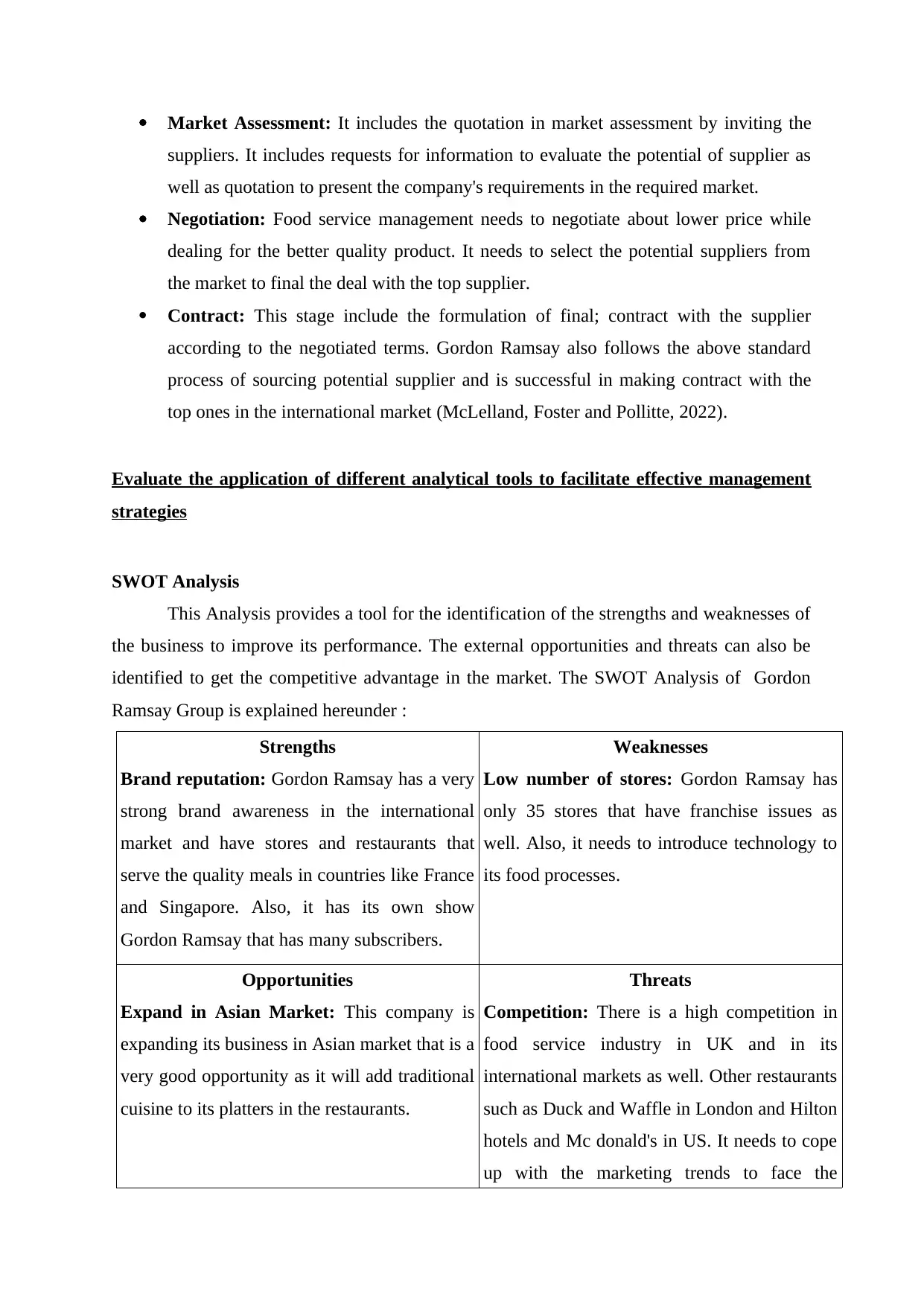
Market Assessment: It includes the quotation in market assessment by inviting the
suppliers. It includes requests for information to evaluate the potential of supplier as
well as quotation to present the company's requirements in the required market.
Negotiation: Food service management needs to negotiate about lower price while
dealing for the better quality product. It needs to select the potential suppliers from
the market to final the deal with the top supplier.
Contract: This stage include the formulation of final; contract with the supplier
according to the negotiated terms. Gordon Ramsay also follows the above standard
process of sourcing potential supplier and is successful in making contract with the
top ones in the international market (McLelland, Foster and Pollitte, 2022).
Evaluate the application of different analytical tools to facilitate effective management
strategies
SWOT Analysis
This Analysis provides a tool for the identification of the strengths and weaknesses of
the business to improve its performance. The external opportunities and threats can also be
identified to get the competitive advantage in the market. The SWOT Analysis of Gordon
Ramsay Group is explained hereunder :
Strengths
Brand reputation: Gordon Ramsay has a very
strong brand awareness in the international
market and have stores and restaurants that
serve the quality meals in countries like France
and Singapore. Also, it has its own show
Gordon Ramsay that has many subscribers.
Weaknesses
Low number of stores: Gordon Ramsay has
only 35 stores that have franchise issues as
well. Also, it needs to introduce technology to
its food processes.
Opportunities
Expand in Asian Market: This company is
expanding its business in Asian market that is a
very good opportunity as it will add traditional
cuisine to its platters in the restaurants.
Threats
Competition: There is a high competition in
food service industry in UK and in its
international markets as well. Other restaurants
such as Duck and Waffle in London and Hilton
hotels and Mc donald's in US. It needs to cope
up with the marketing trends to face the
suppliers. It includes requests for information to evaluate the potential of supplier as
well as quotation to present the company's requirements in the required market.
Negotiation: Food service management needs to negotiate about lower price while
dealing for the better quality product. It needs to select the potential suppliers from
the market to final the deal with the top supplier.
Contract: This stage include the formulation of final; contract with the supplier
according to the negotiated terms. Gordon Ramsay also follows the above standard
process of sourcing potential supplier and is successful in making contract with the
top ones in the international market (McLelland, Foster and Pollitte, 2022).
Evaluate the application of different analytical tools to facilitate effective management
strategies
SWOT Analysis
This Analysis provides a tool for the identification of the strengths and weaknesses of
the business to improve its performance. The external opportunities and threats can also be
identified to get the competitive advantage in the market. The SWOT Analysis of Gordon
Ramsay Group is explained hereunder :
Strengths
Brand reputation: Gordon Ramsay has a very
strong brand awareness in the international
market and have stores and restaurants that
serve the quality meals in countries like France
and Singapore. Also, it has its own show
Gordon Ramsay that has many subscribers.
Weaknesses
Low number of stores: Gordon Ramsay has
only 35 stores that have franchise issues as
well. Also, it needs to introduce technology to
its food processes.
Opportunities
Expand in Asian Market: This company is
expanding its business in Asian market that is a
very good opportunity as it will add traditional
cuisine to its platters in the restaurants.
Threats
Competition: There is a high competition in
food service industry in UK and in its
international markets as well. Other restaurants
such as Duck and Waffle in London and Hilton
hotels and Mc donald's in US. It needs to cope
up with the marketing trends to face the
Paraphrase This Document
Need a fresh take? Get an instant paraphrase of this document with our AI Paraphraser
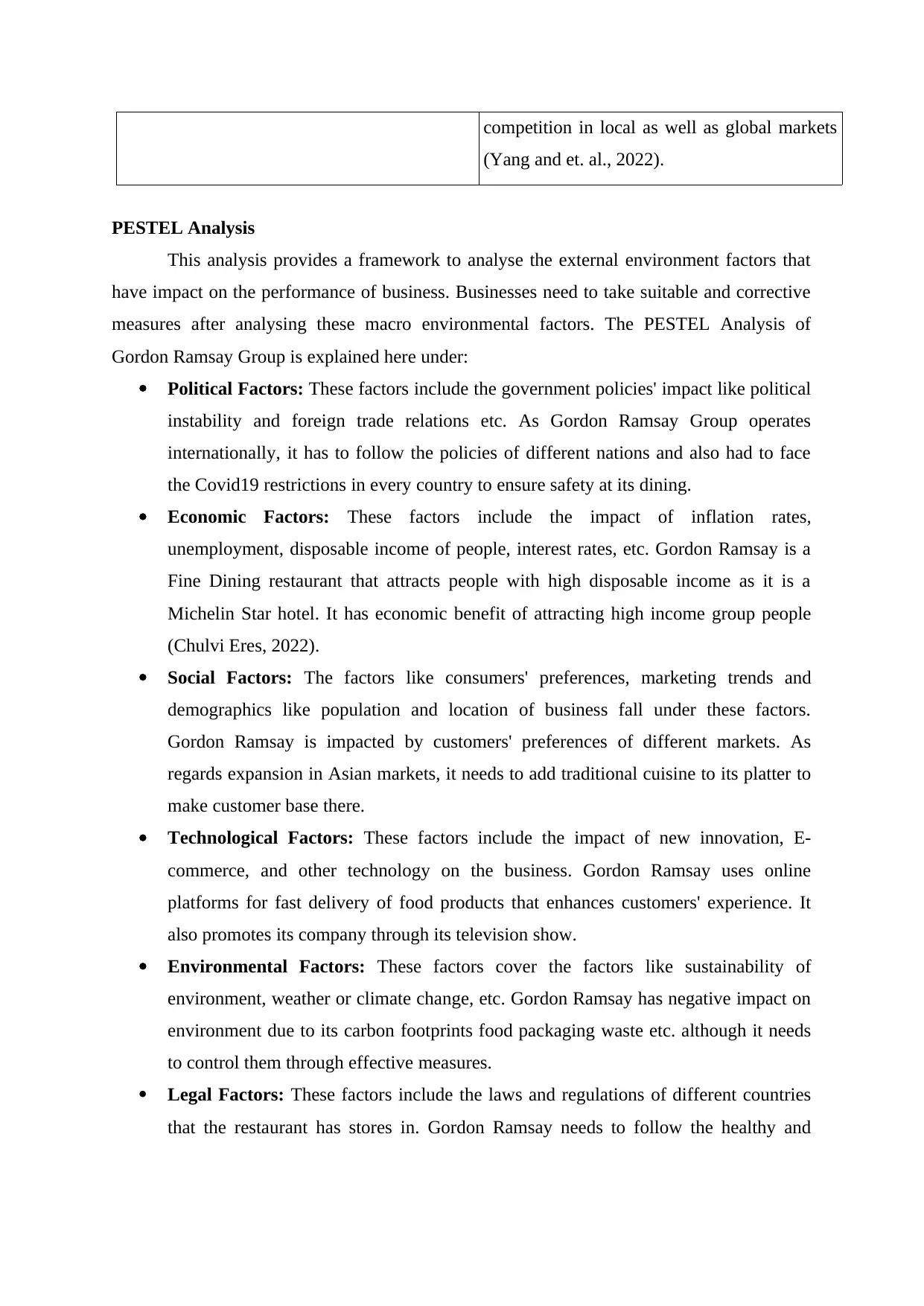
competition in local as well as global markets
(Yang and et. al., 2022).
PESTEL Analysis
This analysis provides a framework to analyse the external environment factors that
have impact on the performance of business. Businesses need to take suitable and corrective
measures after analysing these macro environmental factors. The PESTEL Analysis of
Gordon Ramsay Group is explained here under:
Political Factors: These factors include the government policies' impact like political
instability and foreign trade relations etc. As Gordon Ramsay Group operates
internationally, it has to follow the policies of different nations and also had to face
the Covid19 restrictions in every country to ensure safety at its dining.
Economic Factors: These factors include the impact of inflation rates,
unemployment, disposable income of people, interest rates, etc. Gordon Ramsay is a
Fine Dining restaurant that attracts people with high disposable income as it is a
Michelin Star hotel. It has economic benefit of attracting high income group people
(Chulvi Eres, 2022).
Social Factors: The factors like consumers' preferences, marketing trends and
demographics like population and location of business fall under these factors.
Gordon Ramsay is impacted by customers' preferences of different markets. As
regards expansion in Asian markets, it needs to add traditional cuisine to its platter to
make customer base there.
Technological Factors: These factors include the impact of new innovation, E-
commerce, and other technology on the business. Gordon Ramsay uses online
platforms for fast delivery of food products that enhances customers' experience. It
also promotes its company through its television show.
Environmental Factors: These factors cover the factors like sustainability of
environment, weather or climate change, etc. Gordon Ramsay has negative impact on
environment due to its carbon footprints food packaging waste etc. although it needs
to control them through effective measures.
Legal Factors: These factors include the laws and regulations of different countries
that the restaurant has stores in. Gordon Ramsay needs to follow the healthy and
(Yang and et. al., 2022).
PESTEL Analysis
This analysis provides a framework to analyse the external environment factors that
have impact on the performance of business. Businesses need to take suitable and corrective
measures after analysing these macro environmental factors. The PESTEL Analysis of
Gordon Ramsay Group is explained here under:
Political Factors: These factors include the government policies' impact like political
instability and foreign trade relations etc. As Gordon Ramsay Group operates
internationally, it has to follow the policies of different nations and also had to face
the Covid19 restrictions in every country to ensure safety at its dining.
Economic Factors: These factors include the impact of inflation rates,
unemployment, disposable income of people, interest rates, etc. Gordon Ramsay is a
Fine Dining restaurant that attracts people with high disposable income as it is a
Michelin Star hotel. It has economic benefit of attracting high income group people
(Chulvi Eres, 2022).
Social Factors: The factors like consumers' preferences, marketing trends and
demographics like population and location of business fall under these factors.
Gordon Ramsay is impacted by customers' preferences of different markets. As
regards expansion in Asian markets, it needs to add traditional cuisine to its platter to
make customer base there.
Technological Factors: These factors include the impact of new innovation, E-
commerce, and other technology on the business. Gordon Ramsay uses online
platforms for fast delivery of food products that enhances customers' experience. It
also promotes its company through its television show.
Environmental Factors: These factors cover the factors like sustainability of
environment, weather or climate change, etc. Gordon Ramsay has negative impact on
environment due to its carbon footprints food packaging waste etc. although it needs
to control them through effective measures.
Legal Factors: These factors include the laws and regulations of different countries
that the restaurant has stores in. Gordon Ramsay needs to follow the healthy and
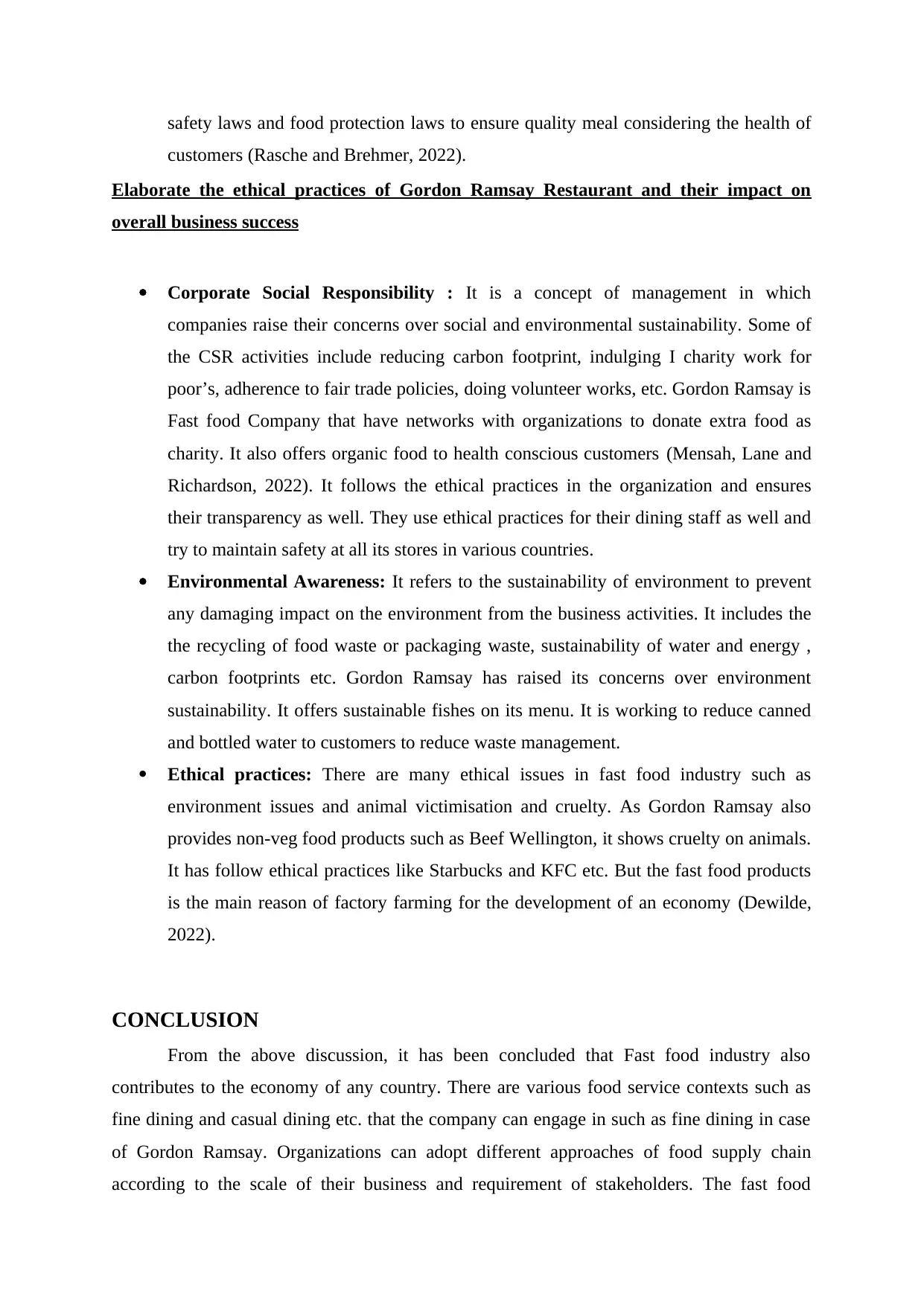
safety laws and food protection laws to ensure quality meal considering the health of
customers (Rasche and Brehmer, 2022).
Elaborate the ethical practices of Gordon Ramsay Restaurant and their impact on
overall business success
Corporate Social Responsibility : It is a concept of management in which
companies raise their concerns over social and environmental sustainability. Some of
the CSR activities include reducing carbon footprint, indulging I charity work for
poor’s, adherence to fair trade policies, doing volunteer works, etc. Gordon Ramsay is
Fast food Company that have networks with organizations to donate extra food as
charity. It also offers organic food to health conscious customers (Mensah, Lane and
Richardson, 2022). It follows the ethical practices in the organization and ensures
their transparency as well. They use ethical practices for their dining staff as well and
try to maintain safety at all its stores in various countries.
Environmental Awareness: It refers to the sustainability of environment to prevent
any damaging impact on the environment from the business activities. It includes the
the recycling of food waste or packaging waste, sustainability of water and energy ,
carbon footprints etc. Gordon Ramsay has raised its concerns over environment
sustainability. It offers sustainable fishes on its menu. It is working to reduce canned
and bottled water to customers to reduce waste management.
Ethical practices: There are many ethical issues in fast food industry such as
environment issues and animal victimisation and cruelty. As Gordon Ramsay also
provides non-veg food products such as Beef Wellington, it shows cruelty on animals.
It has follow ethical practices like Starbucks and KFC etc. But the fast food products
is the main reason of factory farming for the development of an economy (Dewilde,
2022).
CONCLUSION
From the above discussion, it has been concluded that Fast food industry also
contributes to the economy of any country. There are various food service contexts such as
fine dining and casual dining etc. that the company can engage in such as fine dining in case
of Gordon Ramsay. Organizations can adopt different approaches of food supply chain
according to the scale of their business and requirement of stakeholders. The fast food
customers (Rasche and Brehmer, 2022).
Elaborate the ethical practices of Gordon Ramsay Restaurant and their impact on
overall business success
Corporate Social Responsibility : It is a concept of management in which
companies raise their concerns over social and environmental sustainability. Some of
the CSR activities include reducing carbon footprint, indulging I charity work for
poor’s, adherence to fair trade policies, doing volunteer works, etc. Gordon Ramsay is
Fast food Company that have networks with organizations to donate extra food as
charity. It also offers organic food to health conscious customers (Mensah, Lane and
Richardson, 2022). It follows the ethical practices in the organization and ensures
their transparency as well. They use ethical practices for their dining staff as well and
try to maintain safety at all its stores in various countries.
Environmental Awareness: It refers to the sustainability of environment to prevent
any damaging impact on the environment from the business activities. It includes the
the recycling of food waste or packaging waste, sustainability of water and energy ,
carbon footprints etc. Gordon Ramsay has raised its concerns over environment
sustainability. It offers sustainable fishes on its menu. It is working to reduce canned
and bottled water to customers to reduce waste management.
Ethical practices: There are many ethical issues in fast food industry such as
environment issues and animal victimisation and cruelty. As Gordon Ramsay also
provides non-veg food products such as Beef Wellington, it shows cruelty on animals.
It has follow ethical practices like Starbucks and KFC etc. But the fast food products
is the main reason of factory farming for the development of an economy (Dewilde,
2022).
CONCLUSION
From the above discussion, it has been concluded that Fast food industry also
contributes to the economy of any country. There are various food service contexts such as
fine dining and casual dining etc. that the company can engage in such as fine dining in case
of Gordon Ramsay. Organizations can adopt different approaches of food supply chain
according to the scale of their business and requirement of stakeholders. The fast food
⊘ This is a preview!⊘
Do you want full access?
Subscribe today to unlock all pages.

Trusted by 1+ million students worldwide
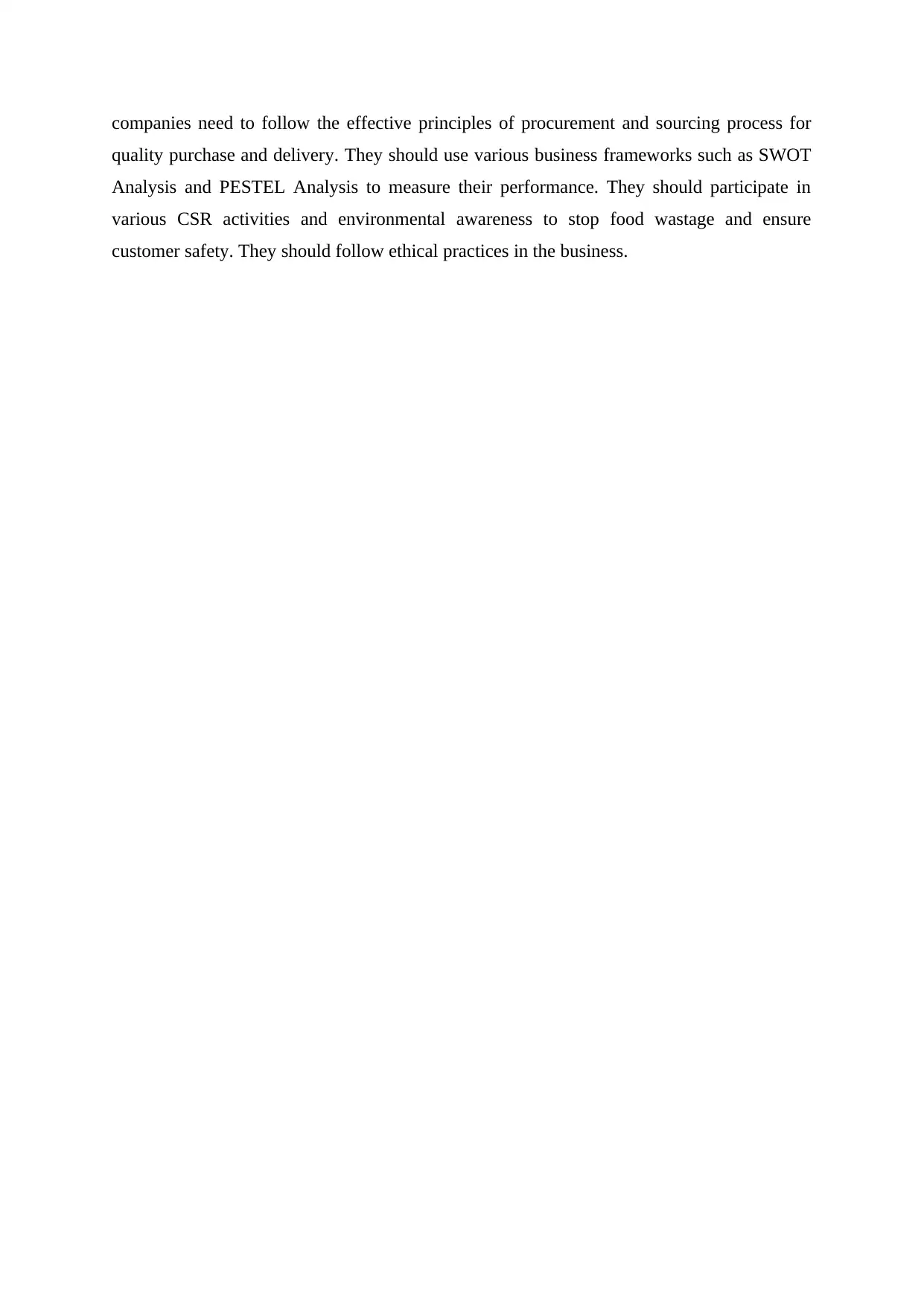
companies need to follow the effective principles of procurement and sourcing process for
quality purchase and delivery. They should use various business frameworks such as SWOT
Analysis and PESTEL Analysis to measure their performance. They should participate in
various CSR activities and environmental awareness to stop food wastage and ensure
customer safety. They should follow ethical practices in the business.
quality purchase and delivery. They should use various business frameworks such as SWOT
Analysis and PESTEL Analysis to measure their performance. They should participate in
various CSR activities and environmental awareness to stop food wastage and ensure
customer safety. They should follow ethical practices in the business.
Paraphrase This Document
Need a fresh take? Get an instant paraphrase of this document with our AI Paraphraser

REFERENCES
Books and Journals
Cheng, H., and et. al.,2022. Recent advances in intelligent food packaging materials:
Principles, preparation and applications. Food Chemistry, 375, p.131738.
Chulvi Eres, E., 2022. Análisis de mejora y viabilidad de un sistema de información en una
empresa de reparación y mantenimiento de maquinaria industrial (Doctoral dissertation,
Universitat Politècnica de València).
Dewilde, P., 2022. On ecological ethics. In Strategies for Sustainability of the Earth System
(pp. 33-63). Springer, Cham.
Fraundorfer, M., 2022. Global Food Production. In Global Governance in the Age of the
Anthropocene (pp. 161-201). Palgrave Macmillan, Cham.
Lee, S. and Esteve, M., 2022. What drives the perceived legitimacy of collaborative
governance? An experimental study. Public Management Review, pp.1-22.
Massimiliano, B. and Luigi, C., 2022. Transitioning into circular food consumption practices:
An analytical framework. In Circular Economy and Sustainability (pp. 385-407). Elsevier.
McLelland, M.A., Foster, J. and Pollitte, W., 2022. Perceptual deterrents of the green
consumer. Qualitative Market Research: An International Journal.
Mensah, F.Z., Lane, K.E. and Richardson, L.D., 2022. Determinants of eating behaviour in
Black, Asian and Minority Ethnic (BAME) university students when living at and away from
home: With a focus on the influence of food enculturation and food acculturation. Appetite,
p.105932.
Rasche, C. and Brehmer, N., 2022. Toward a Conceptual Framework of Hybrid Strategies in
Healthcare: Co-Alignment of Market and Non-Market Activities. In Service Design Practices
for Healthcare Innovation (pp. 39-57). Springer, Cham.
Torres, I. and López-Cevallos, D.F., 2022. School food approaches in Peru, Colombia and
Ecuador. School Food, Equity and Social Justice: Critical Reflections and Perspectives, p.2.
Vasilakakis, K. and Sdrali, D., 2022. Supplier selection criteria in the Greek hotel food and
beverage divisions. Journal of Hospitality and Tourism Insights.
Yang, Y., and et. al.,2022. Design and application of intelligent teaching space for blended
teaching. Interactive Learning Environments, pp.1-18.
Books and Journals
Cheng, H., and et. al.,2022. Recent advances in intelligent food packaging materials:
Principles, preparation and applications. Food Chemistry, 375, p.131738.
Chulvi Eres, E., 2022. Análisis de mejora y viabilidad de un sistema de información en una
empresa de reparación y mantenimiento de maquinaria industrial (Doctoral dissertation,
Universitat Politècnica de València).
Dewilde, P., 2022. On ecological ethics. In Strategies for Sustainability of the Earth System
(pp. 33-63). Springer, Cham.
Fraundorfer, M., 2022. Global Food Production. In Global Governance in the Age of the
Anthropocene (pp. 161-201). Palgrave Macmillan, Cham.
Lee, S. and Esteve, M., 2022. What drives the perceived legitimacy of collaborative
governance? An experimental study. Public Management Review, pp.1-22.
Massimiliano, B. and Luigi, C., 2022. Transitioning into circular food consumption practices:
An analytical framework. In Circular Economy and Sustainability (pp. 385-407). Elsevier.
McLelland, M.A., Foster, J. and Pollitte, W., 2022. Perceptual deterrents of the green
consumer. Qualitative Market Research: An International Journal.
Mensah, F.Z., Lane, K.E. and Richardson, L.D., 2022. Determinants of eating behaviour in
Black, Asian and Minority Ethnic (BAME) university students when living at and away from
home: With a focus on the influence of food enculturation and food acculturation. Appetite,
p.105932.
Rasche, C. and Brehmer, N., 2022. Toward a Conceptual Framework of Hybrid Strategies in
Healthcare: Co-Alignment of Market and Non-Market Activities. In Service Design Practices
for Healthcare Innovation (pp. 39-57). Springer, Cham.
Torres, I. and López-Cevallos, D.F., 2022. School food approaches in Peru, Colombia and
Ecuador. School Food, Equity and Social Justice: Critical Reflections and Perspectives, p.2.
Vasilakakis, K. and Sdrali, D., 2022. Supplier selection criteria in the Greek hotel food and
beverage divisions. Journal of Hospitality and Tourism Insights.
Yang, Y., and et. al.,2022. Design and application of intelligent teaching space for blended
teaching. Interactive Learning Environments, pp.1-18.
1 out of 11
Related Documents
Your All-in-One AI-Powered Toolkit for Academic Success.
+13062052269
info@desklib.com
Available 24*7 on WhatsApp / Email
![[object Object]](/_next/static/media/star-bottom.7253800d.svg)
Unlock your academic potential
Copyright © 2020–2025 A2Z Services. All Rights Reserved. Developed and managed by ZUCOL.


